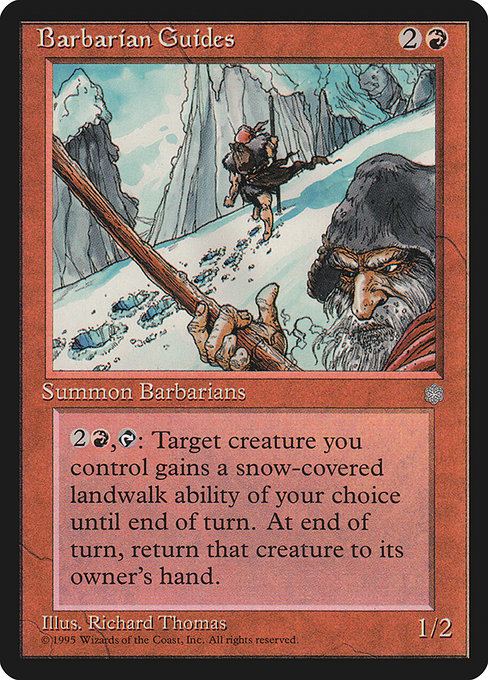
Image courtesy of Scryfall.com
Templating and Understanding Through Barbarian Guides
When we crack open a card from Magic’s earliest days, we’re not just peering at a creature with a neat stat line—we’re peeking into a design philosophy that often assumes a smoother learning curve than the reality many players faced. Templating, the way rules text is worded and structured, shapes how quickly we can parse what a card actually does. The red card Barbarian Guides from Ice Age is a perfect case study for this, because its ability is a compact, multi-part spell that demands careful reading and a moment of cognitive juggling. 🧙♂️🔥
Barbarian Guides is a Creature — Human Barbarian with a modest 1/2 body, costed at {2}{R}. Its true flavor shines in the activated ability: “{2}{R}, {T}: Choose a land type. Target creature you control gains snow landwalk of the chosen type until end of turn. Return that creature to its owner's hand at the beginning of the next end step. (It can't be blocked as long as defending player controls a snow land of that type.)” This sentence is a compact novella on templating—enough to trip up a new player who assumes “landwalk” means “can’t be blocked by anything.” The added wrinkle—conditioning the effect to end of turn and then returning the creature to the hand—turns a temporary evasion into a tempo swing with built-in downsides. 💎
Card snapshot: what you’re really reading
- Mana cost: {2}{R}
- Type: Creature — Human Barbarian
- Power/Toughness: 1/2
- Set and rarity: Ice Age, common
- Oracled text: {2}{R}, {T}: Choose a land type. Target creature you control gains snow landwalk of the chosen type until end of turn. Return that creature to its owner's hand at the beginning of the next end step. (It can't be blocked as long as defending player controls a snow land of that type.)
Forced to interpret this line-by-line, a player is asked to parse two» separate timing events: the activation is a single-turn spell that both grants a temporary evasion and triggers a delayed return. It’s a perfect micro-example of how templating compresses rule knowledge into a small, dense block of text. The “snow landwalk” mechanic—anchored to the chosen land type—also relies on an understanding of the Ice Age-era keyword system, where snow lands were a thing of the past, and the way land types interact with blocking is not always front-and-center for newer players. This is where teaching tools, like explicit step-by-step reasoning or a quick card-audit ritual, can help players internalize the structure. 🧱🎲
Rule-of-thumb for readers: first identify cost and type, then separate the effects by parentheses—what changes this turn, what happens next turn, and what the condition actually guarantees or limits.
Why templating matters in practice
Templates shape comprehension, and comprehension shapes decisions. In a fast-paced draft or a casual commander game, a card like Barbarian Guides can influence tempo far beyond its stat line. The urge to “just do something” can overshadow the need to assess duration and restrictions. If you read quickly, you might miss that the landwalk applies only to the chosen land type and that the creature returns to hand at the start of the next end step—an important nuance if you’re racing to finish the game or trying to keep two or three threats on the board. The templating pushes players to slow down and articulate what each component does in sequence: cost, target, effect, duration, and timing. 🧭⚔️
Designers have historically balanced accessibility with complexity by layering information: a simple mana cost, a defensible combat stat, and then a multi-clause ability that challenges but rewards careful reading. Ice Age-era cards like Barbarian Guides capture that moment in Magic’s evolution when templating matured into a precise, if occasionally cryptic, craft. The result is a durable lesson for players and educators alike: a card isn’t just a set of rules—it’s a mini-lesson in how information is structured for quick retrieval under pressure. 🎨🧠
Strategies for teaching templating in the classroom of the kitchen table
- Chunk the text: Break the ability into the activation cost, the action, the duration, and the outcome. Have players recite each part aloud to reinforce parsing.
- Use concrete examples: Imagine a board with a Mountain or an Island and walk through how the landwalk affects blocking and how the return-to-hand timing changes the post-turn state.
- Offer visual aids: Simple flow diagrams showing order-of-operations help, especially for tricky phrases like “until end of turn” and “beginning of the next end step.”
- Relate to modern templating: Compare with current templating conventions—how do newer cards express similar effects more transparently, and where do they still rely on cultural MTG literacy?
In the end, the learning payoff is more than just understanding one card. It’s about building a toolkit for reading any complex effect: identify cost, identify the active and lasting parts, and track timing windows. Barbarian Guides becomes a teaching aid, a nostalgic nod to the era of Ice Age, and a reminder that a card’s wording can be a puzzle as much as a spell. And if you’re thinking about ways to share this with friends or your local shop, you can pair a chat about templating with a stylish accessory—the Neon Phone Case with Card Holder MagSafe Polycarbonate—that keeps your deck notes and slips neatly organized on the go. 🧙♂️💎
Neon Phone Case with Card Holder MagSafe PolycarbonateMore from our network
- Analyzing Boulderbranch Golems Archetype Engagement in MTG
- MTG Throne of Bone: Power, Toughness, and Ratios Explained
- Blue Hot Star Motion Reconstructed: Proper Motions Across 12,378 Parsecs
- Color Index 337 Reveals Temperature-Driven Spectrum of a Distant Hot Giant
- Design Strategies to Reduce Support Load Today